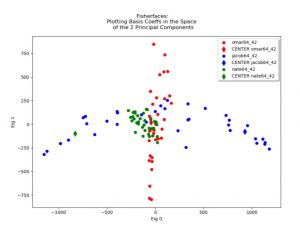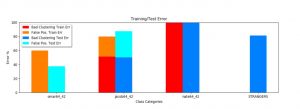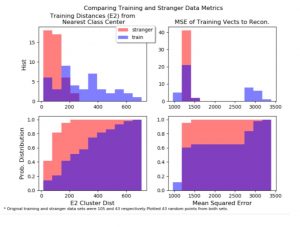- What did you personally accomplish this week on the project? Give files or photos that demonstrate your progress. Prove to the reader that you put sufficient effort into the project over the course of the week (12+ hours).
This week I went over-time in the amount of work I did. I was hoping to put sufficient work to cover not only the expectations this week but also for the next two weeks. My work is summarized below.
-
-
- Finished implementation Local PCA. Resulted were poor. This led to the developments in the next points.
- Completed implementation of Global PCA. Results were better but not good enough. Used library version of K-means to cluster. Implemented classes to recognize arbitrary image using the clustering.
- Implemented a script that uses identifies faces in real-time (combines my work related to Global PCA, LDA, Fisherfaces).
-
-
-
- Completed LDA and Fisherfaces implementation. Our implementation improved our training and testing accuracy by about 10% (to about 45% per class across 3 classes). However, we are still not getting the performance we need. We believe we are not correctly implementing LDA as our clustering is not exhibiting the traits that LDA is characteristic of (see below clustering with 3 classes projected into a C – 1 = 2-dimensional space).

-
-
-
- Developed algorithms to delineate between a stranger and non-stranger. I devised two methods for detecting strangers.
-
- Use an images E2 K-means distance. This distance is its distance to the nearest centroid. If this distance is larger than some threshold we consider the image as that of a stranger. We decide the threshold value by taking it as the E2 K-means distance of the training data (e.g. 75% of training data images had E2 distance <= 500 so the threshold is 500)
- Similar threshold to before except we use the reconstruction mean-squared error as a metric.
This method seemed promising but it did not work out. Below is a chart summarizing the source of inaccuracies we detected in our training and testing. The False Positive part of the stacked bar represent errors where our k-means correctly predicted the identity but because of our thresholding we designated that image as a stranger.

In order to understand why, I visualized how the E2 and MSE metrics for training data and stranger data compared (below). As you can see, my implicit hypothesis was that stranger images would have larger E2 distances and larger MSE’s than the training data. This was not the case, unfortunately. I am still working on a solution to the problem of detecting strangers.

- Is your progress on schedule or behind? If you are behind, what actions will be taken to catch up to the project schedule?
-
- On schedule.
-
- What deliverables do you hope to complete in the next week?
- Since I accomplished much more than what I had to this week, I may take it easy for the next two weeks. The work I have been doing has been exciting so I may make progress anyways.
